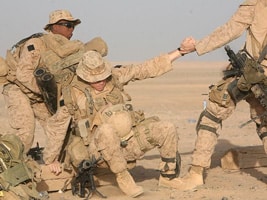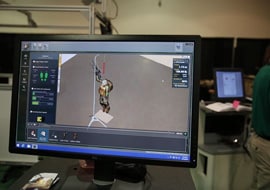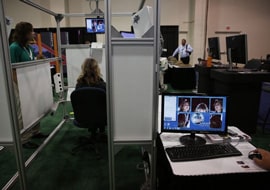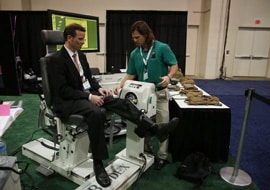
The Gruntworks Squad Integration Facility showcased its latest initiatives to lighten and streamline the individual loads Marines carry into combat during the Navy League’s 2015 Sea, Air, Space exposition in mid-April.
On display was an advanced 3-D body scanner, a sophisticated computer simulation program, and a state-of-the art medical device commonly used by professional sports teams to measure performance and stress on joints.
Together, they provide Gruntworks’ Marine Expeditionary Rifle Squad with an invaluable suite of tools to collect information and test gear that will ensure Marines of the future can both out gun and out run enemy fighters.
“This information helps us improve the fit of equipment like helmets and body armor,” said Mark Richter, the director of Gruntworks’ Marine Expeditionary Rifle Squad team, which is focused on individual mobility.
Over the years, new gear from better body armor to improved rifle optics and night vision — and the batteries they need to run — have added pounds to Marines’ packs. Today many carry more than 100 pounds into combat, up from the average 60 pound pack grunts carried during Vietnam.
Adding all that weight is a problem Richter said. In addition to draining Marines’ energy, it places dangerous stress on their joints, which can lead to fatigue, sprains or long-term problems like arthritis or chronic back injuries. The MERS team works with the mantra “ounces equal pounds and pounds equal pain.”
But the challenge is far more complex that just gross weight, Richter said. Marines must also be flexible, fast and able to fit through hatches, urban windows and small rooms.
“Combat burden is more than just weight — it’s a combination of weight, bulk and stiffness,” he said. “We’re looking at things like how quickly the Marine is able to get through a doorway with his or her equipment, how the rifle interfaces with the body armor, or whether something interferes with or obstructs the Marine’s ability to engage a target.”
Here’s a look at a few of Gruntworks’ flagship technologies.
GruntSim

Perhaps the most significant piece of wizardry on display by Gruntworks was a body mechanics computer simulator called GruntSim. Using a 3-D computer-aided design capability, it allows gear developers to kit up a Marine avatar any way they can imagine before running them through a virtual obstacle course.
It is reminiscent of many popular first-person shooter games like the “Medal of Honor” series, but with a very serious purpose. As the avatar runs the course, the program highlights each joint in green, yellow or red depending on the amount of stress a particular combination of tasks and kit puts on a Marine’s body. Green is good. Red is not.
Developers can select one of several avatars, ranging from a petite woman to a hulking man formulated after measuring the bodies of countless Marines. It highlights how different body types might handle the same load. The model is sophisticated enough to calculate not just how gear will affect joints, a Marine’s center of gravity and flexibility.
The program was originally developed by the University of Iowa, said Roger Wood, a systems engineer with MERS. The Office of Naval Research began refining the program in 2010 and worked to train Marine personnel to use it starting in October. Marine officials requested a few tweaks to the software and a finished product was delivered to Gruntworks on April 16.
As developers design new gear, they can add 3-D models to the program to see how they affect Marine mobility as they run through the simulated obstacle course. If a virtual test shows the gear fits and doesn’t put undue pressure on joints, Gruntworks might mock up a real-world prototype, put it on live Marines and run them through an actual obstacle course. If the simulation flags too many problems, designers head back to the drawing board.
It prevents injuries, but also offers the service potential time and cost savings by avoiding unnecessary field trials, Richter said.
3-D body scanner

GruntSim wouldn’t be as useful without the true-to-life avatars that reflect average body measurements taken from across the fleet. Gruntworks’ 3-D scanners make that possible.
On display at SAS was an abbreviated five-camera head scanner, But at Marine Corps Base Quantico, Virginia, the organization has a full-body version used to capture the measurements of hundreds of Marines.
The service used to take measurements manually, said Evan Luo an engineer with Gruntworks. But it was labor intensive, and each person doing the measuring did it slightly differently. The data was also tough to capture, and the last time the service conducted a full survey in 2010 it took three months to complete, Luo said.
With 3-D scanners, developers have a virtual model of each Marine in perpetuity meaning they come back to it for limitless measurements at any time.
If, for example, developers are working on new binoculars and need to know the average distance between a Marine’s pupils, they can go back to scanned models and capture that measurement, Richter said. Under the old method, they might have to conduct a new survey if they didn’t measure for that in the past.
Dynamometer

Typically used by sports teams for physical rehabilitation or to test performance, Gruntworks uses a Biodex brand dynamometer to measure potential stresses on joints caused by various tasks.
For example, if the Marine Corps needs to design a nob on a hatch that all healthy Marines are capable of turning, designers can produce a prototype and attach it to the machine. They can then test a pool of Marines reflective of the entire fleet to determine how much resistance they can reasonably handle and still complete the task.
Richter said the device is now being used to test future steering wheels for the Amphibious Combat Vehicle that will ensure a Marine can still steer the heavy ship-to-shore connector if the power steering system fails.